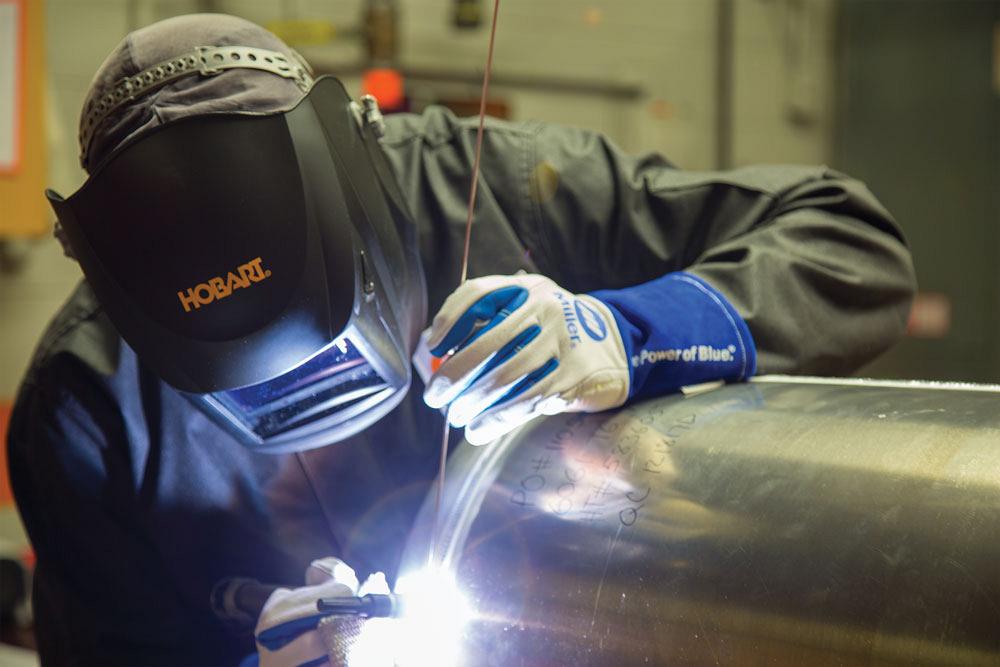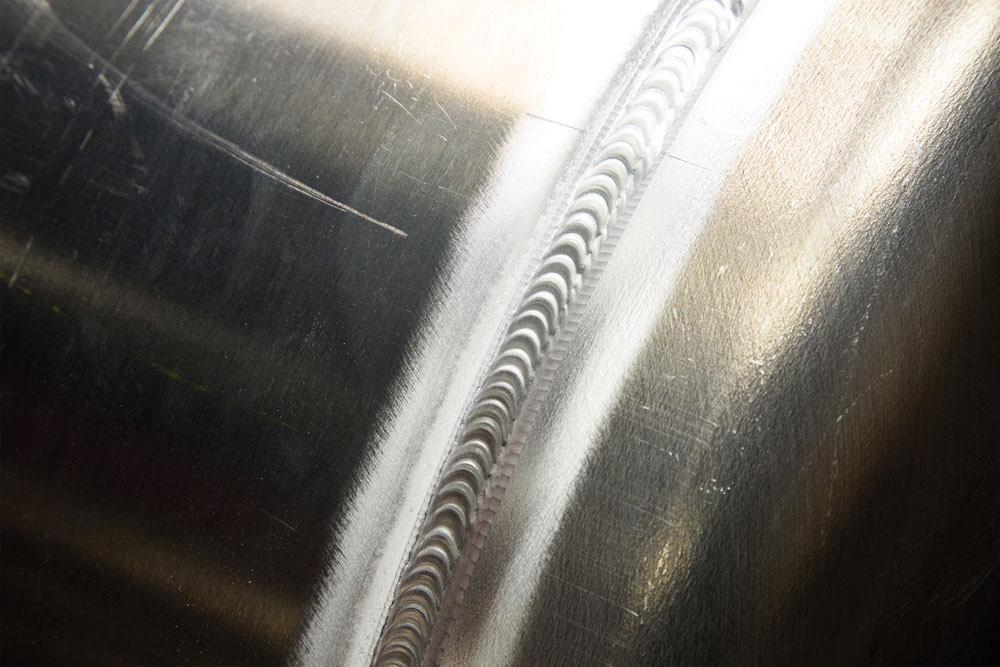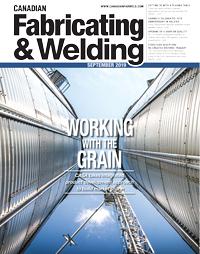Applications Engineering Manager
- FMA
- The Fabricator
- FABTECH
- Canadian Metalworking
Aluminum under the wire
Choosing the right filler metal requires careful consideration of all product factors
- By Blaine Guy
- Updated February 3, 2023
- September 25, 2019
- Article
- Welding

Any discussion of the challenges involved in aluminum welding must address the nature of aluminum itself. The most important difference to note in terms of the storage and preparation of aluminum is that aluminum oxide forms on the surface of the material.
In any discussion of welding aluminum, a comparison usually is made to welding steel. Shops that are broadening their market into aluminum welding inevitably understand that it has different properties that affect process and consumable choices. Here we discuss a few of those differences, and the main considerations a welder must address to prepare for and choose the right filler metal to make a clean, efficient, and quality aluminum weld.
Storage and Prep
Any discussion of the challenges involved in aluminum welding must address the nature of aluminum itself. The most important difference to note in terms of storage and preparation of aluminum is that aluminum oxide forms on the surface of the material. This attracts moisture, whether it be humidity in the air or standing water on the material itself. When it absorbs that moisture, it creates a hydrated aluminum oxide. Sometimes this is insignificant enough that you won’t see it, and sometimes it is significant enough to form what is often called “white rust.”
Whether or not you can see this aluminum oxide, it can cause porosity in your weld and issues with fusion into the base metal.
Therefore, it’s important that aluminum oxide be cleaned with some form of degreaser or an acetone solution and removed with a stainless steel wire brush dedicated solely for this purpose to avoid contamination. Degreasing removes moisture/contamination on the material surface. Wire brushing removes the aluminum oxide.
Hydrogen is highly soluble in liquid aluminum, so when aluminum turns to liquid during a weld, it absorbs any hydrogen nearby. This hydrogen could come from impure shielding gas, contaminated filler wire, from the base material, or humidity in the environment. When the liquid aluminum solidifies, the hydrogen rushes to escape, creating bubbles of porosity. If the treatment of the surface is carefully managed before welding and porosity still occurs, other potential factors should be considered as culprits and managed out of the process.
Hot Cracking Care
Two other key issues are connected to aluminum welding are cracking and lack of fusion. Each can affect how you approach your weld and your choice of filler metal.
It is typically hot cracking or centreline cracking that affects aluminum welds. As a weld solidifies, what are known as “eutectic compositions,” which have lower melting temperatures, will migrate to the weld centreline, be the last to solidify, and create the potential to crack the weld apart.
In steel, these low melting point temperature elements are often referred to as “tramp elements” and tend to be an indication that the steel is not of the highest quality. In aluminum, however, it is the material we put into the aluminum on purpose to improve the properties and performance of it that causes the problems. These additions include such materials as magnesium, silicon, copper, zinc, and manganese. Pure aluminum is fairly weak, which is why alloys of it have been created – to give aluminum the strength, corrosion resistance, toughness, and other properties for which it is prized in industry.
A major factor in matching aluminum filler and base materials is the chemistry of the completed weld deposit, which is a combination of the base and filler metal chemistries. For instance, consider the most common base aluminum material, 6061. You would never weld two pieces of 6061 aluminum together with 6061 filler metal – there’s a reason such a filler metal doesn’t exist. 6061 aluminum has a chemistry that is very susceptible to hot cracking if arc welded. Filler metals that are suggested to use on it are designed to dilute that chemistry to a less crack-sensitive composition and avoid that problem.
At the same time, this isn’t as significant with 5XXX series base materials like 5454, 5083, 5086, and 5456 – four base materials that are commonly welded with filler metals of closely matching chemistry. You can use filler metals with similar chemistries for many aluminum base materials that do not have chemistries that are susceptible to hot cracking, but it’s important to appreciate which metals may have this issue.
If there is a risk of cracking, it’s important that the weld joint design allow enough filler metal to be introduced to achieve enough dilution of the materials. For instance, a square butt joint – essentially two pieces of aluminum butting against each other like two books flat on a desk – leaves you no room for the filler metal, therefore you cannot substantially dilute away from the crack-sensitive chemistry. In this case, it may be necessary to chamfer the edges of each piece to create a bevel, thereby producing a channel in which more filler metal can be introduced, the base material can be diluted, and the result is a chemistry that is at lower risk of hot cracking.
Fusion Fixes
Aluminum is a very good thermal conductor. The challenge this creates is that when you put a focused arc on the workpiece, aluminum pulls that heat away very quickly, which can lead to a lack of fusion.
This problem becomes more of a concern as the material gets thicker. You have to put a lot of energy in to get the material to melt and achieve adequate fusion. When you hear a welder talking about welding “hot and fast” on an aluminum weld, that is the reason: to overcome that thermal conductivity. Although this is more a question of technique rather than material, it’s important to understand the reason for that lack of fusion.
Filler Metal Considerations
Our company has a toll-free number that welders can call for help determining which filler metal they should be using on a particular job. Quite often they know the alloy they are working with and may think that is sufficient information to make a filler metal choice. However, a host of other weld qualities must be addressed. Many different filler alloys can weld 6061 parts together. A few of the questions you should ask to ensure you are choosing the best filler metal for your application are:
- Does it need to be corrosion-resistant?
- What kind of shear or tensile strength is required of the weld?
- What sort of ductility is required of the weld? For instance, 4XXX series filler metals have lower ductility than 5XXX series filler metals.
- Will a colour match be necessary after anodizing?
- Will the part be used in elevated-temperature service, between 150 and 350 degrees F (66 and 180 degrees C)?
- Is cracking sensitivity a primary concern?
- Is the weld required to respond to post-weld heat treatment?
- What level of toughness – the ability of the weldment to deform plastically in the presence of stress raisers – is expected of the weldment?
It’s important that whoever is given the task of procuring the filler metal understand the primary needs of the weldment in this respect.
Common Options
All that said, a vast majority of aluminum weld applications use either 4043 or 5356 filler metal alloys. These have become the go-to choices for their qualities.
4043 was originally developed not for welding but as a brazing alloy. The principal alloying element is silicon, which makes the weld flow or wet out very nicely and gives the welds excellent resistance to hot cracking. This wire can produce a clean, shiny finish with low to no black smut, which can be present with other alloys. For this reason, gas metal arc welding (GMAW) welders often prefer this filler metal because it runs nicer, it flows/wets out better, and has a shiny, clean finish when they lay a bead. It makes the welder’s job easier.
5356 is used for more demanding applications. It has the right combination of strength, ductility, and toughness. For parts involved in cyclic loading, where there’s a concern about fatigue, 5356 is going to win out over 4043 because of that strength, ductility, and toughness.
Ultimately, welders would like an option that is easy to work with like 4043 but has some of the strength of 5356, and there are filler metals that fit somewhere in between. 4643, for instance, is a filler metal that was developed to bump up 4043’s strength and also create a weld that is heat-treatable. This was achieved by adding some magnesium in with the silicon used in 4043. Magnesium and silicon are in 6061, which is what makes that alloy heat-treatable and gives it its strength, but the silicon level is lower in the 6061 than what was used in this filler metal.
4643 was designed and is still used as a specialty alloy for post-weld heat treat applications rather than as a replacement for 4043.
A new filler metal, 4943, takes the formula used for 4643 and, among other upgrades, adds more magnesium to get a greater amount of strength in the weld with the ability to be heat treated. It’s also being marketed as a standard to replace 4043 rather than as a specialty item. While it doesn’t completely supplant the divide between 4043 and 5356, it’s a filler metal that adds strength in a job that would previously have used 4043.
If changing from 4043 to 4943, you can keep the weld sized the same and increase the overall strength. If increasing the strength is not a benefit, you could reduce the weld size with 4943 and still keep the originally designed strength. In other words, a weld that might have required three passes with 4043 might require only one using 4943.
As mentioned previously, while 4043 and 5356 filler metal alloys have risen above the rest as go-to options, your job may require a slightly different mix of attributes. By discussing the key questions above with your filler metal supplier, and understanding the other challenges related to aluminum welding, you can make a more informed decision.
Blaine Guy is applications engineering manager at Hobart Brothers LLC, 400 Trade Square East, Troy, Ohio 45373, 937-332-5347, www.hobartbrothers.com.
About the Author
subscribe now


Keep up to date with the latest news, events, and technology for all things metal from our pair of monthly magazines written specifically for Canadian manufacturers!
Start Your Free Subscription- Trending Articles
Aluminum MIG welding wire upgraded with a proprietary and patented surface treatment technology

Achieving success with mechanized plasma cutting

Hypertherm Associates partners with Rapyuta Robotics

Gema welcomes controller

Brushless copper tubing cutter adjusts to ODs up to 2-1/8 in.

- Industry Events
MME Winnipeg
- April 30, 2024
- Winnipeg, ON Canada
CTMA Economic Uncertainty: Helping You Navigate Windsor Seminar
- April 30, 2024
- Windsor, ON Canada
CTMA Economic Uncertainty: Helping You Navigate Kitchener Seminar
- May 2, 2024
- Kitchener, ON Canada
Automate 2024
- May 6 - 9, 2024
- Chicago, IL
ANCA Open House
- May 7 - 8, 2024
- Wixom, MI
















